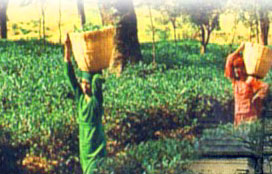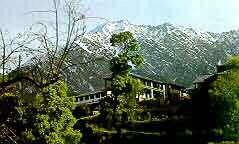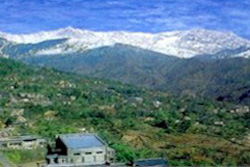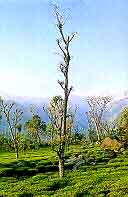|
Travelogues Palampur: Traveller's Cup of Tea
|
|||||||||||||||||||||||
|
More on Himachal • At a Glance
Travelogues
Impressions
Trekking | ||||||||||||||||||||||
That it is a place to indulge in soliloquy, or one that makes you whistle spontaneously, or one of those rare places you would choose, if given a choice as to where you would like to live and die, is a description I have never come across in any travel writing. Not because it calls for a different kind of travel writer, but because it requires a befitting destination - Palampur. Not merely unique because of its British tea plantation legacy or for that matter its natural beauty and salubrious climate, but for many other reasons each more unique than the other. Nestling in a dark green shelter of that awesome snow crowned spectacle which geography calls the Dauladhar mountain ranges, at a height of 4,000 feet, is a verdant valley in the rather wide lap of it's mighty neighbour, the Dhauladhar. Known as the Kangra valley, a place of many historical upheavals. While Kangra town itself is better known as an historical entity, it is Palampur which attracts tourists who wish to see life beyond Shimla or Nainital.
As the clouds hit and rise over the mighty Dhauladhars, they wash Palampur clean with rain that descends as suddenly as it vanishes. Stray clouds then enter this quaint British tea town, often wrapping the pretty bungalows and cottages which dot the landscape., From a distance the impression is of a huge green golf course, albeit somewhat darker, with pretty little golf huts that complete the perfect picture.
Dhauladhars, are themselves a mountain range quite apart from any other in the Himalayas, unlike the Pir Panjal or the Great Himalayan range. Dhauladhars are dark granite ranges with rock faces so sharply cut that they fail to contain the snow. As a result the snow is seen in streaks with only the caps crowned.
Besides the occasional tourist, you will come across smiling and radiant tea pickers who dot the landscape. The package is complete with sloping slate stone roofs on pretty cottages and villas, originally made by the British, now owned by retired army officers, their families and their pampered, disobedient pet dogs ! And everywhere the Dhauladhars loom large in snow-crowned regalia. The climate and weather that seems to change almost every hour is hand in glove with the brazen beauty of the place. It is a place of many sub-seasons within each season, resplendent in it's various hues and colours that seem to change throughout the day.
Thanks perhaps to the limited availability of tourist accommodation, there are very few tourists. The cosmopolitan appeal of Palampur is enhanced by the residents who have inherited a British legacy and now occupy their pretty houses with large gardens filled with Hydrangea in sylvan isolated surroundings. They are either Anglo Indians or retired Army officers with a western outlook, as well as attire. One also comes across pretty Gurkha tea pickers with their baskets tied around their foreheads. But the most striking people who lend the most natural cultural influence are the Gaddis, a nomadic pastoral tribe, inhabitants of the Dhauladhar ranges. Fair skinned and handsome, they have fine features with closely set eyes. They are tough and sturdy given the harsh conditions of living in the Dhauladhar ranges. They make the most reliable trekking guides as they know this wonderful trekking region like the back of their hands. They have a remarkable knack of forecasting the weather and can tell you with shocking accuracy when it will rain, how hard and for how long. Taking advantage of a scenic spot, Himachal Pradesh Tourism has set up a cafe' against the backdrop of the Dhauladhars, adjacent to the Neughal Khad and the Bundla river in the vicinity of tea gardens. Difficult to ask for a better location, Neughal Cafe' has become the place to spend an evening with a cool glass of beer, or a cold drink or even more appropriately, tea freshly picked from the gardens. Himachal Pradesh Tourism has yet another property in a beautiful location. The appropriately named Hotel T-Bud is right in the middle of tea plantations. An elegant place with rather large, spacious well kept rooms, it remains the best hotel to stay in. Prompt service gives you well cooked meals in your room or in a smallish restaurant on the ground floor of this two storied building. In front is a large lawn where one could while away time taking in the fragrant air and the lovely weather. There is also a little park for children. By the side of the reception area, you can buy or refer to tourist literature on Himachal Pradesh.Some other hotels are also there. But it is Hotel T Bud that is most appropriately located. Around Palampur are several places worth visiting. Andretta is a place where Mrs Norah Richards, a disciple of Mahatma Gandhi, started rural theatre. There is the Sobha Singh Art Gallery with painting themes of Sohni - Mahiwal ( the Punjabi lovers), Omar Khayyam and Heer Ranjah. Al Hilal, an erstwhile military bastion of Maharajah Ranjit Singh of Kashmir. Dr Karan Singh now runs the place, which has been converted to Palace Motel and is managed by his son.
|
|||||||||||||||||||||||
Editor: Romola Butalia (c) India Travelogue. All rights reserved. |
|||||||||||||||||||||||
 It may be time to congratulate a great geographical collision. Had it not been for the Australasia landmass invading the level dignity of the main land of Asia, there would have been no Himalayas. A retrospective tragedy of Himalayan proportions. Many ranges have come up since. Everest, it is said, is rising. Mumbai is supposed to be sinking. As long as everything does not become level, I am happy ! So we now have the Karakoram Range in Pakistan and in Pakistan Occupied Kashmir. The Dhauladhars and Pir Panjal. As well as the Great Himalayan range. And of course the Shivaliks for those who go to the Himalayas to escape the tropical heat of the plains and for little else.
It may be time to congratulate a great geographical collision. Had it not been for the Australasia landmass invading the level dignity of the main land of Asia, there would have been no Himalayas. A retrospective tragedy of Himalayan proportions. Many ranges have come up since. Everest, it is said, is rising. Mumbai is supposed to be sinking. As long as everything does not become level, I am happy ! So we now have the Karakoram Range in Pakistan and in Pakistan Occupied Kashmir. The Dhauladhars and Pir Panjal. As well as the Great Himalayan range. And of course the Shivaliks for those who go to the Himalayas to escape the tropical heat of the plains and for little else. 
 A place named as innocuously as its reputation - PALAMPUR. Specific, simple and meaningful. Palam means water and literally it is a place full of water. With its numerous brooks and the roaring Neughal Khad, a 1000 feet chasm with the torrential Bundla stream going through it.
A place named as innocuously as its reputation - PALAMPUR. Specific, simple and meaningful. Palam means water and literally it is a place full of water. With its numerous brooks and the roaring Neughal Khad, a 1000 feet chasm with the torrential Bundla stream going through it.
 It is a hill station with a difference. Unlike Darjeeling or Ooty , which are surrounded by tea plantations, Palampur is set upon tea plantations, with numerous gurgling brooks that flow through the town in different directions. Also, Palampur is God-sent for those who like long walks, for the town seems to spread endlessly all around. Little paths through the undulating greens of tea gardens makes the walk easy, long and delightful, something like a stroll through an endless, well landscaped golf course.
It is a hill station with a difference. Unlike Darjeeling or Ooty , which are surrounded by tea plantations, Palampur is set upon tea plantations, with numerous gurgling brooks that flow through the town in different directions. Also, Palampur is God-sent for those who like long walks, for the town seems to spread endlessly all around. Little paths through the undulating greens of tea gardens makes the walk easy, long and delightful, something like a stroll through an endless, well landscaped golf course.
 It's almost as if Geography, by creating the Dhauladhars has killed two birds with one stone : halting an easy access beyond Palampur, and stopping rain clouds which are then forced to rise, washing the tea gardens clean and adding that magical aroma and fragrance of freshly washed earth.
It's almost as if Geography, by creating the Dhauladhars has killed two birds with one stone : halting an easy access beyond Palampur, and stopping rain clouds which are then forced to rise, washing the tea gardens clean and adding that magical aroma and fragrance of freshly washed earth.